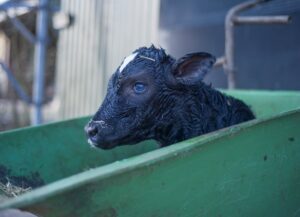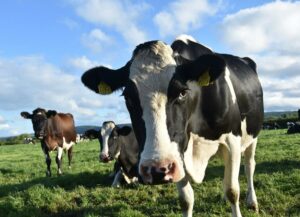María Villagrasa & Nuria García
Udder cleft dermatitis (dermatitis) is an inflammation of the skin of the udder that is often located between the front teats and in the area where the front quarters attach to the abdominal wall. The area appears with scabs, erythema and exudation, and smells bad. In the most severe cases, bleeding and necrosis can be observed.
It is diagnosed mostly during milking and older cows are more likely affected. Injuries can be classified as mild or severe depending on their appearance or size. As a result of this problem the cow’s well-being is compromised and both milk production and its quality are reduced, causing significant economic losses to the farm.
Although different risk factors have been identified, they only explain a small part of the variation observed in the prevalence of dermatitis. Some research suggests these factors are different depending on whether the dermatitis is mild or severe. It is also believed there is a link between this dermatitis and other cow health problems such as mastitis and hock lesions.
Given the lack of longitudinal studies on this topic, a group of researchers from the National Veterinary Institute of Sweden (Ekman et al., 2020) tracked dairy herds for a year, studying the incidence of new cases, the risk factors associated with the transition from healthy to mild or severe dermatitis, and its duration. In addition, the relationships between dermatitis and other health problems, such as clinical mastitis, somatic cell counts (SCC) and hock lesions, were also investigated.
A total of seven herds with Swedish dairy cattle (mainly Holstein and Swedish Red) participated in the study, based on the following inclusion criteria:
- prevalence of dermatitisof 15 to 60% in an earlierdermatitis study
- use of a milking parlor and free stall system
- herds signed in the official Swedish milk registration system (Vaxa Sverige)
Each herd was visited nine times, approximately every six weeks and for a year in the morning or afternoon milking. A case of dermatitis was defined when one or more consecutive observations of dermatitis were made.
Injuries were scored from 0 to 5, where 0-1 corresponded to absence of dermatitis, 2 corresponded to mild dermatitis (small scabs, papules or pustules, often in combination with redness of the skin), and 3-5 to severe dermatitis (large scabs, cracked skin).
All cows were examined at milking time for dermatitis at the attachment of the front of the udder with the abdomen, and between the front quarters. Each cow was also rated for three udder conformation traits, hygiene and the presence of hock injuries.
The conformation traits of the udder were:
- depth (distance from the base of the udder to the hock)
- attachment of the front of the udder (angle between the front of the udder and the abdominal wall)
- presence of a cleft at the attachment of the front of the udder (yes or no)
The hygiene score was based on the rear leg area above the hock and had a scale of 1 (clean) to 3 (more than two dirt stains).
Prevalence, incidence and risk factors for udder cleft dermatitis
The overall prevalence, including cows in all herds, ranged from 22 to 29% for any type of dermatitis, from 12 to 19% for mild dermatitis and from 7 to 11% for severe dermatitis. For most herds, the prevalence of mild dermatitis fluctuated more between visits than severe dermatitis. This could be due to recurrent cases of mild dermatitis and mild cases lasting shorter than severe ones.
The incidence found in this study was high compared to other common ailments such as mastitis (0.09 cases/cow/year between 2017 and 2018). However, herds in this study were known to previously have had on average a high prevalence of dermatitis. Because the incidence rate in combination with the duration of injuries affects the prevalence of herd dermatitis, herds in the study were likely to have a higher incidence rate than the average Swedish dairy herd.
The risk factors associated with going from healthy to having dermatitis included: udder conformation, hygiene, parity, breed, DIM (days in milk), results of milking tests and disorders treated by veterinarians during the study period.
Risk factors for transition to dermatitis were analyzed in three separate transition models:
- Transition from healthy to any type of dermatitis
- Transition from healthy to mild dermatitis
- Transition from healthy or mild dermatitisto severe dermatitis
Transition from unaffected to having any type of dermatitis and mild dermatitis
Factors associated with the transition from unaffected to any type of dermatitis and mild dermatitis were breed, DIM, cleft in the udder attachment, and milk urea.
The first three factors along with parity are closely related and can increase the risk of dermatitis. It is known that increasing parity and DIM changes the conformation of the udder, particularly depth and attachment, traits associated with dermatitis in previous research. This indicates that, in this study, the cleft in the udder attachment was more important as a risk factor for any type of dermatitis than other udder conformation traits.
With regards to milk urea it was found that a low concentration (less than 3.7 mmol/l) was associated with a lower risk of transition to any type of dermatitis; the importance of this risk factor should be further investigated, since it could also be a methodological error.
Transition from unaffected to severe dermatitis
The risk of a transition to severe dermatitis was higher in cows that produced more than 39.7 kg of milk compared to those producing 24.7 to 29.6 kg. Udder pressure and the presence of edema at the beginning of the lactation can reduce blood flow and impair the skin protective barrier at the attachment area of the front of the udder. These conditions are more likely to occur in high-producing dairy cows. In fact, cows with a higher production and a higher negative energy balance have less resistance to reproductive problems, ketosis and laminitis, and may also be more prone to dermatitis.
The risk of a transition to severe dermatitis was also higher in cows with mild dermatitis in the previous observation, compared to those who did not; in fact, the association between mild and severe dermatitis was more common than the transition between healthy cow and severe dermatitis. This finding emphasizes the importance of preventing and curing minor injuries.
Relationship between dermatitis and other health problems
With regards to other problems SCC and hock injuries were not associated with the transition to any type of dermatitis. Only in the case of clinical mastitis it was observed that the transition to severe dermatitis increased the risk of developing mastitis within six weeks after the diagnosis of dermatitis.
In the analysis of the duration of this ailment, cases of dermatitis with a known onset lasted an average of six weeks. However, because most cases had unknown starting and end dates, the total duration was most likely underestimated.
Conclusions
- Breed and udder conformation are important risk factors for any type of dermatitis.
- Milk production and having a mild dermatitis injury are important risk factors for a transition to severe
In short, complex associations between breed, udder conformation, milk production and parity can together increase the risk of dermatitis.
Reference
Ekman L, Nyman AK, Persson Waller K. Incidence of udder cleft dermatitis (UCD) in dairy cows and risk factors for transitions to UCD. J Dairy Sci. 2020 Dec;103(12):11736-11749.
© 2021 Dairy Knowledge Center. All Rights Reserved.











